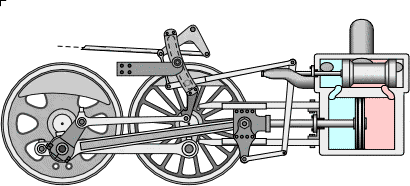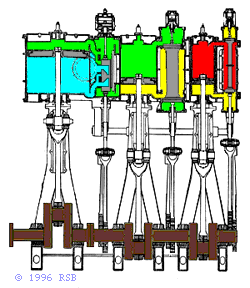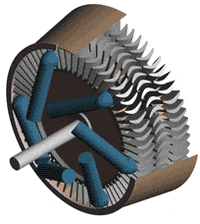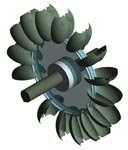TL:DR: i want to make a better steam engine for literally no reason
I've been reading a lot of completely irrelevant stuff since i can't go back to work for another week, and i eventually made it to steam engines. The old kind, like, boilers, trains, stationary engines, etc... I think it's an extension of wanting to build stuff in metal, casting, machining, welding, and so on, but i can't be sure. When i came off the pain killers last week i was reading all about steam powered stuff so i don't remember how i got here, but i decided to stay awhile.
These days there are lots of people making small model steam engines, such as these, and some people using functional ones as tools in a shop. None of these are new-ish designs. Obviously internal combustion engines and elecrtic motors took over and have won the war for a whole host of reasons. I can't begin to fathom building an internal combustion engine from scratch, but it seems like making steam engines is common place. Why not try to improve them?
There are tons of valve designs. the 'normal' one is the slide valve like on a train:

it's reversible (because trains want to go backwards too) and has some 'tunability' for how long the intake port stays open. That's the thing, steam is hot and pressurized, so you get best efficiency if you use the expansion of the steam. you do this by shutting the intake port earlier in the 'power stroke' and letting expanding steam do some of the work. Some ship engines and stationary engines also put the steam through multiple cylinders to take advantage of all the expansion:

Those are called compound engines. Steam enters small cylinder, expands a bit, goes to the next one, expands more, and so on. Sometimes 4 cylinders with steam only entering the first one. These are actually more efficient than steam turbines at low speed, but WAY less efficient than diesel engines. larger cylinders are the lower pressure ones, allowing for all cylinders to have similar power output.
The most efficient ones seem to be corliss type engines, with valves that open rapidly at the beginning of the power stroke, and then cut off immediately at a variable point. It's controlled by the governor, so it's always operating at the same speed, but when more power isn't needed, it increases efficiency by cutting off earlier. It's crazy to watch: valves and pushrods and dashpots, oh my! Pic of something similar if you don't want to watch video:

It's really interesting, it runs the throttle wide open but varies the valve opening for throttle control. Sound familiar? This was invented in 1849. Genius. It also uses cylindrical valves that rotate, poppet valves weren't quite figured out yet and don't really work so well for steam i guess. One issue there is they can't move very fast. it uses gravity or air suction to pull the intake valve shut after cut off. The simplicity of the slide valve above also seems to be better for high speed applications, like trains, which need to go balls out (a term i recently learned came from centrifugal ball governors commonly found on steam engines) for a long period of time.
There has to be a way to get the efficiency of one with the speed of the other, right?
The other problem i saw was airflow:

Not sure how well air can flow smoothly there. THe exhaust (pink space) for max efficiency should escape as easily as possible. The corliss mentioned above has separate exhaust valves so the exhaust can go straight out the bottom, which also helps not cool down the intake port. but even then, it all empties into a box with a single outlet:

The intake goes into like a plenum thing, too, which i'm not sure is necessary for steam engines. I think it has more to do with technology of the time and simplicity. One tube from the boiler into a larger space inside a strong casting to hold the pressure. Pressure is serious on these things, no ambient +2 bar of boost like a high power internal combustion engine, we're talking hundreds of pounds of pressure sometimes.
You don't need to worry about helmholz resonance or whatever that's called, shorter is always better for intake runners. Shorter is better for almost everything, shorter distance from boiler to engine, shorter distance between cylinders in compound engines, basically always try to keep the heat in the steam engine until the steam is exhausted to air or a condenser.
The low speed vs. high speed engines have different 'clearance' too. Clearance is the amount of space in the cylinder at TDC. High speed engines have lots of clearance and open the intake valve slightly before TDC, i think the idea is to fill the space with as much steam as possible by the time TDC happens, because stuff is moving fast and some of those locomotives have HUGE cylinders. like over a foot bore. One nice thing is the lack of detonation, all pressure operated, no fire (except in the boiler).
Have any of you ever though about combining some of these with some more modern type valvetrain stuff? I've seen small model engines with a cam and roller instead of the steam engine 'eccentric' and i think that's a good start. Some large steam engines used cams but at very low speeds, and if you can get variable cam duration with valves that can close rapidly at high speed i think that would be the key. If modern valve springs can close a valve, rocker, and pushrod at 7k rpm, then surely something could be designed for a steam engine to close rapidly at less than half that rpm. I came up with some ideas, but i'm currently learning CAD so it'll be a little while before i have the software skills to actually model it.
what are your ideas? modern materials? make poppet valves work? should i seek psychiatric help? Seriously, if i could do any work in the garage i would be doing it (though technically i would be back at work if i could do that) but i can't just sit and do nothing.


































